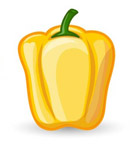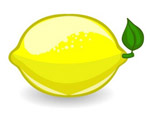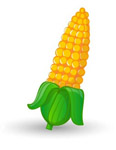Learning basic vocabulary in a foreign language can be a dull task. It doesn’t make much sense to go through a long list of translations and to memorize
So this is how you should really use the following list: don’t try to remember the connection between the English word and its translation; rather look at the picture and try to remember which French, Spanish or German word represents it.
| French | Spanish | German | |
|---|---|---|---|
 apple |
une pomme /pɔm/ |
la manzana /manˈθana/ or /manˈsana/ |
der Apfel -s, die Äpfel /ˈapfəl/ |
 banana |
une banane /banan/ |
el plátano /ˈplatano/ |
die Banane, -n /baˈnaːnə/ |
 beetroot |
une betterave rouge /bɛtʁav ʁuʒ/ |
la remolacha /remoˈlatʃa/ (Spain) or el betabel/betaˈβel/ (Mexico) |
die Rote Bete, -n /ˈʁoːtə ˈbeːtə/ or die Rote Rübe, -n/ˈʁoːtə ˈryːbə/ |
 bell pepper |
un poivron /pwavʁɔ̃/ |
el pimiento morrón /piˈmjento moˈron/ |
der Paprika -s, -s or Paprika /ˈpapʁɪka/ |
 blackberry |
une mûre /myʁ/ |
la zarzamora /θaɾθaˈmoɾa/ or /saɾsaˈmoɾa/ can be called also just “mora” |
die Brombeere, -n /ˈbʁɔmˌbeːʁə/ |
 carrot |
une carotte /kaʁɔt/ |
la zanahoria /θanaˈoɾja/ or /sanaˈoɾja/ |
die Möhre, -n /ˈmøːʁə/ or, depending on die Karotte, -nthe dialect: /kaˈʁɔtə/ |
 cucumber |
un concombre /kɔ̃kɔ̃bʁ/ |
el pepino /peˈpino/ |
die Gurke, -n /ˈɡʊʁkə/ |
 garlic |
un ail /aj/ |
el ajo /ˈaxo/ |
der Knoblauch -(e)s, -e /ˈknoːˌblaʊχ/ |
 lemon |
un citron /sitʁɔ̃/ |
el limón /liˈmon/ |
die Zitrone, -n /tsiˈtʁoːnə/ |
 maize/corn |
le maïs uncountable /mais/ |
el maíz /maˈiθ/ or /maˈis/ |
der Mais des Mais(es), no plural /maɪs/ |
 pear |
une poire /pwaʁ/ |
la pera /ˈpeɾa/ |
die Birne, -n /ˈbɪʁnə/ |
 onion |
un oignon or un ognon both /ɔɲɔ̃/ |
la cebolla /θeˈβoʎa/ or /seˈβoʎa/ |
die Zwiebel, -n /ˈtsviːbəl/ |
 orange |
une orange /ɔʁɑ̃ʒ/ |
la naranja /naˈɾaŋxa/ |
die Orange, -n /oˈʁãːʒə/ |
 pineapple |
un ananas /ananas/ or /anana/ |
la piña /ˈpiɲa/ |
die Ananas pl. Ananas /ˈananas/ |
 potato |
une pomme de terre /pɔmdətɛʁ/ |
la patata (Spain) /paˈtata/ or la papa (L.Am.)/ˈpapa/ |
die Kartoffel, -n /kaʁˈtɔfl/ |
 strawberry |
une fraise /fʁɛz/ |
la fresa /ˈfɾesa/ |
die Erdbeere, -n /ˈeːɐtbeːʀə/ |
 tomato |
une tomate /tɔmat/ |
el tomate /toˈmate/ In some parts of Mexico, “tomate” refers only to a green tomato, and a red tomato is referred to as “jitomate”. |
die Tomate -n /toˈmaːtə/ |
 Tip: Are you a non-native English speaker? I have just finished creating a
Tip: Are you a non-native English speaker? I have just finished creating a  Web App
Web App
